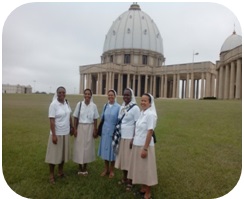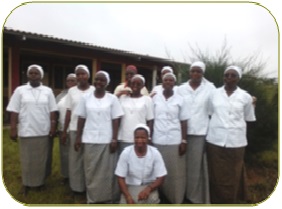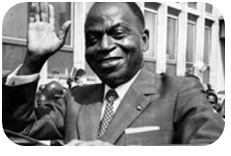Inter-Saint Joseph Meeting
A little reminder: this Inter-St Joseph gathering in West Africa first took place in Burkina Faso in December2004/January 2005when formators from the four St. Joseph congregations came together.
We met, at the request of our superiors, to put together a shared formation programme. This was the first of several meetings. July 2006 saw the first of our inter-Saint Joseph meetings at Brin in Senegal where there were 42 participants from the congregations of Annecy, Aosta, the Institute and Lyon.
At the end of this Brin meeting, the decision was taken that each congregation would delegate a fully professed African sister to play a part in animating a common novitiate. The aim was to reflect together on our presence in Africa.
Sister Marie Astic of the Institute was given the responsibility of coordinating this team which would be composed of regional leaders, junior mistresses, novice mistresses and delegates of the fully professed sisters.
We expressed a wish to meet every five years. Then we prepared the 2011 retreat session at Mundasso, Burkina Faso. The chosen theme was ‘Our apostolic life in the light of the Eucharistic Letter – for a better proclamation of the Gospel, in the service of our neighbour’. There were forty of us. Among other decisions, it was agreed that the common novitiate would be at Nianing in Senegal.
The latest gathering was prepared by delegates from the four congregations, with the approval of our Major Superiors. We were warmly welcomed by the Dominicans at their Faith School Centreat Yamoussoukro in Ivory Coast. Our focus was our charism of ‘the Double and Total Union, Communion and Sisterhood’. There were 37 participants.
The Programme
Monday, 21st August
Our day began with the Eucharist, the heart of our life. At 9.15 a.m., we gathered round Sr. Marie Angelique who, as an elder, shared her experience of the charism with us. How were we to live it today in a world that confronts us with new challenges? She helped us recognise that it is a charism of communion that we are living (or trying to live). We were then shown some photos and invited to choose one and talk about how it spoke to us about our charism.
Among the key points that emerged are the importance of:
- Living simplicity together;
- Holding each other in tenderness and love;
- Welcoming differences and listeningcarefully;
- Trying to help a sister who finds herself in a difficult situation;
- Praying for each other;
- Living out the unity that exists among us in spite of our differences of ministry, country or culture;
|
Living communion through collaboration and solidarity;
- Feeling oneself to be a member of a congregation;
- Trusting each other.
After this, we divided into groups to talk about our Constitutions. This was followed by a plenary session where we fedback whathad struck us most:
- Putting the Lord at the centre of our life (prayer, Eucharist, mission)
- Witnessing in our littleness
- Taking St. Joseph as our model (simplicity, service, gentleness …)
- Living Christ’s Word … that all may be one.
We were then shown two Powerpoint presentations, the first on the charism and the second on the history of the Sisters of St. Joseph of Annecy. This was followed by time to reflect on the day so far. For us, the charism is:
- Gospel word lived out

- A gift from God, lived for others
- A gift from God, the Father’s plan for his creatures.
It gives identity and develops a sense of belonging. Sister Marie Angelique summarised it, telling us that we entered the convent with gifts and limitations. If we truly want to live our charism, we must each combat whatever hinders communion.
The day ended with prayer and the Salve Regina.
Tuesday 22nd August : Mary, Queen of the Universe
Tuesday began at 7.30 with Mass. At 9.20 we met again for prayer and a presentation about the charism of communion we have inherited from our first Sisters.
- The charism expresses what we are to live out.
- It is a state of mind that results in particular attitudes and choices.
- It is a way of relating to others, to God and to oneself.
- It has been handed down to us from the First Sisters. Fr. Medaille had noticed in them a special way of living out the Gospel – the desire to love and serve each person with the same love as Christ, and the search for perfection and for God in everything,
|
First and foremost, the charism is an experience of God. Our sisters before us were ‘seized’ by Christ. A strong desire impelled them to give themselves totally to God. Jean Pierre Medaille himself, fashioned by love for Christ, wrote: “Just as Christ in the Eucharist is invisible, the Little Design must be invisible in the eyes of the world, but it is to shine out with the love of God and the neighbour”.
The Trinitarian experience is seen in a life of relationship and an openness to the world.As Fr. Medaille wrote ….
- The Father is perfect love
- The Son is nothing to himself but has a passionate love/desire to defeat the sin that enslaves mankind
- The Spirit is Love and stimulates Love
The Double Union is Trinitarian Love in practice and therefore an invitation to work for unity by living and bringing to life this bond of love by nurturing fraternal relationships. Friendliness is one of the great themes of our spirituality. It simplifies life and relationships. But how can we live it in practice?
We reflected on this for a while then watch an animated film about the life of Sisters of St. Joseph in Brazil, how it was lived in the past and is lived today.
LYON
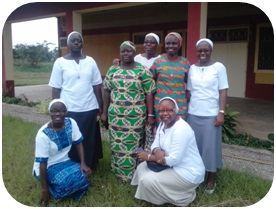
In the second part of her talk, Sr. Angelique spoke about our rootedness in the Trinity and invited us to see each person as a unique being and help them grow and become someone who listens and relates. We need to look at the world with God’s eyes and listen to its expectations and cries for help. We need to read our lives in the light of Christ in order to recognise where he is at work and learn to discern what he is asking of us.At the end of the morning, some role play
situations helped us interiorise what we had heard
and seen inthe film or in our life experiences.
At 3.40 it was back to work again. We resumed our reflection and did an evaluation noting what we had learned, how we felt called (including any new calls) and where we needed to take care.After offering our day to the Lord in evening prayer, we watched ‘Invictus’, a film about Nelson Mandela,and identified points for prayer for the following day. We ended with a hymn to Our Lady.
Wednesday 23rd August
Again, the day began with the Eucharist and morning prayer at 7.30 after which we met in the conference room.There we were invited to share our reactions to ‘Invictus’ and the way it relates to our charism of union. There was, for example, the attitude of the President Mandela and his desire to unite his people. His long years in prison had helped him get to know himself better and to understand his persecutors a little.
The programme for the rest of the day included suggesting ideas for the formation of novices and for missionary works for Sisters of St. Joseph in Africa that would fit in with the charism.
We would like to:
- Continue the inter-St. Joseph sessions; open them to all sisters, so far as possible, so that their value could be appreciated by all sisters.
- Keep the common novitiate
- Publish a newsletter for West Africa two or three times a year.
- Create a coordination office, with a sister from each of the 4 congregations in turn taking responsibility.
- Develop inter-congregational works in order to respond better to the needs of the people. This would necessitate ‘exchanges’ of qualified sisters.
|
Nurture true fraternity among communities living in the same area.
Houphouet Boigny,President of Ivory Coast.1960-1993 |
Have these sessions every 3 instead of every 5 years.
- Have as our next theme either the Maxims or Community Life.
This 3rd West African Inter-St. Joseph meeting drew to a close with a visit to some historic sites in the town of Yamoussoukro, including the Basilica and the Houphouët Boigny foundation.
The idea of a Basilica in honour of peace in Ivory Coast came from Houphouët Boigny, the country’s first president. The basilica can accommodate 7,000 people sitting and 11,000 standing and covers an area of 130 hectares. 158 metres high, the basilica stands as a link between God and mankind in the heart of the land of the Baoulé people.It took 3 years to build and was consecrated by Pope John Paul II on 10 September 1990. Its message is one of peace: all who enter it are invited to be peace-builders.
Our Lady of Peace,
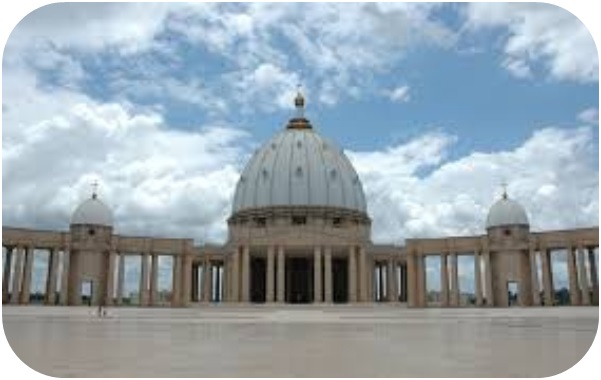


 Annecy
Annecy